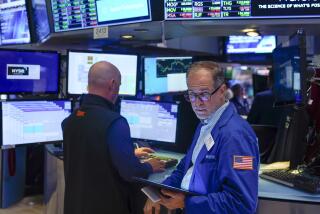Exotic Devices for Investing Worry Wall St.
- Share via
NEW YORK — As the investment world tries to determine how much to blame the stock market crash on computerized program trading and stock index futures, suddenly the creative minds who produced them are under suspicion.
Critics worry that a raft of other exotic investment devices concocted by the same people--a set of highly educated engineers, mathematicians and even physicists known familiarly on Wall Street as “rocket scientists”--may harbor the same potential for financial calamity as the high-tech stock trading of the last few years.
For the handiwork of the “rocket scientists” extends far beyond the stock market. In New York, London, Tokyo and elsewhere, banks and securities houses now commit billions of dollars to trading of investment devices so new that less may be known about their true value than about the physics of a supernova.
In many cases, trading in these so-called “derivative” instruments--interest-rate swaps, floating-rate notes, stripped mortgage securities and their cousins--is far greater than in the conventional stocks and bonds to which they are related.
Especially nerve-racking to government authorities is the large proportion of bank assets devoted to holding and trading these offspring of the Wall Street space labs. One 1985 study of derivative securities and other esoterica owned by 15 major U.S. banks placed the total at well over $1.25 trillion, a sum that handily exceeded the $900 million at risk in Third World bank debt.
The instruments in which all this money is concentrated are so new that until recently none had run through a serious economic or market downturn in which their value and novel contractual provisions were tested. There have been several cases, however, in which they have magnified minor financial jitters into disasters for limited groups of investors. Critics say those were only harbingers of greater problems to come.
“It’s like driving a racing car to work,” one prominent regulator said. “It’s efficient as hell, because you get there in a hurry; but, if a squirrel runs out in front, you wind up wrapped around a tree.”
Moreover, there is little doubt that the offspring of the “rocket scientists” have exceeded the ability of market and banking regulators to oversee them.
“We have 21st-Century capital markets and 19th-Century regulatory authorities,” said Paul M. Sacks, president of Multinational Strategies, a consulting firm specializing in global investment issues.
Regulation Difficult
To complicate matters further, many such instruments are traded in markets that cross national boundaries, remaining outside the jurisdiction of any single government.
As for expecting international financial agencies to exercise any oversight, “international organizations are only as strong as their most powerful member is prepared to let them be--and, in most cases, the buck stops with the United States,” said Susan Strange, a professor of international relations at the London School of Economics.
Most of the new instruments were designed as answers to what is perhaps the financial world’s leading headache: volatility, or the wild swings in price that have afflicted stocks, bonds and currency exchange rates in the 1970s and ‘80s.
Financial historians trace the current era of volatility to 1973, when President Richard M. Nixon uncoupled the U.S. dollar from the system of fixed currency exchange rates established among Western industrialized nations at the end of World War II. By allowing markets rather than governments to set exchange rates, Nixon believed he would reduce the economic strains produced by government-imposed revaluations and devaluations of money.
Instead, the change added a new strain to the system: currency risk. A U.S. business that accumulated a large position in Italian lire from sales of goods in that country, for instance, had to protect itself from the risk that the lira would lose value against the dollar, wiping out any sales profit. So the business would look for an offsetting hedge--a currency investment that would gain in value as the lira fell.
In no time, the volume of currency transactions undertaken to finance real trade outran trade itself. In 1986, when the value of world trade in goods and services was $4 trillion, the volume of transactions in foreign currencies was $65 trillion--meaning that every dollar of trade in material goods inspired, directly or indirectly, $16 in foreign-exchange hedging.
The complexity of hedging techniques and the introduction of powerful computers reached adulthood in the financial world together, fueling each other’s growth. “There are new products that wouldn’t even exist if we didn’t have computers,” Dexter Senft, a managing director and top “rocket scientist” at the investment firm of First Boston, remarked in an interview last year.
Hedging demand soon rose in the bond markets, where careening interest rates in an era of high inflation made the value of bonds unpredictable. The mathematical engineers created interest-rate futures, vehicles for betting on the future direction of rates. These became the most successful new futures contracts ever introduced on Chicago commodity exchanges, long accustomed to trading only in such palpable commodities as grain and livestock. Once the theory of futures trading was transferred to something as intangible as interest rates, futures to bet on the direction of stock prices were not far behind.
The Wall Street mathematicians redefined almost every variety of security. They reworked conventional bonds so that investors could invest in an oil company and, at the same time, place an offsetting wager on the future price of oil. They concocted arrangements in which two corporations exchange their credit ratings, each one borrowing on terms tailored to the other. Thanks to the “rocket scientists,” one can today not only invest in a stock but place a separate bet on its future price and hedge the risk of a wrong answer by laying on yet another bet through the options market.
Higher Profit Margins
Whatever real demand existed for these products was fueled by the Wall Street investment banks that employed their creators. As profit margins for so-called “plain vanilla” financings--stocks and bonds, straight up--shrank under the pressure of competition, they expanded for complex, exclusively designed securities.
Although many financial professionals still insist that the new instruments are indispensable in managing risks in the global financial markets, others are not so sure.
“Economists always say that hedging devices are marvelous because they protect against risk,” Strange of the London School of Economics said, “but they make markets more volatile by expanding the number of deals made.”
Because risk in the financial world is something that can never be extinguished, only passed around, some observers believe that the concentrated efforts of big professional investors to shift risk to one another has itself contributed to, rather than cushioned, the markets’ volatility.
“What regulators worry about is that the community as a whole ends up chasing its tail,” said one prominent regulator who has often sounded alarms about the banking industry’s appetite for exotic risk-deferral investments. “The factors that produce price volatility in the first place provoke innovation, and that process sustains and might even increase volatility. Then, when the markets get hit by some unusual shock, the process can get out of control.”
‘Fair-Weather Markets’
Many regulators find in this month’s stock market crash the echo of smaller crashes in little-known investment markets, where trading in ill-understood investment products overtook investments in conventional securities.
“There have been seize-ups of various kinds in the capital markets over the last several years, although they’ve been less visible and less politically explosive (than the stock crash),” said the banking regulator, who asked to remain unidentified lest his remarks further spook the apprehensive stock market. “We call them fair-weather markets, because they do great in normal times but fall apart at other times.”
This happens in part because, although the amount of money tied up in these markets is huge, each security is only thinly traded, meaning it has a tightly defined market of buyers and sellers.
In the Eurobond market, the London market where banks and other large institutions trade highly esoteric instruments, only an estimated 15% of the $750 billion in outstanding bonds is considered sufficiently tradeable for professionals to move $5-million blocks without significantly distorting the price. If a crisis atmosphere rips through one of these markets, provoking heavy selling, prices simply collapse.
Just within the last year, ostensibly sophisticated institutional investors have lost billions in two of these shadowy markets. In April, Merrill Lynch & Co. lost $377 million--a full three months of profit--when its trading desk overstocked a form of mortgage security in which the principal and income aspects of the bond can be separated, or “stripped,” and sold separately.
In February, investors in what are known as “perpetual floating rate notes,” one peculiar species of London-based security, took a $2-billion bath when the market collapsed.
The growth of these so-called “perps” parallels the cycle of feast and famine that characterizes so many of the new devices. Over a span of 18 months beginning in September, 1985, perps became one of the most popular ways for British banks to raise capital. In some respects, the perp resembled a U.S.-style preferred stock in that it paid a continuous dividend, in this case at a rate that floated with prevailing interest rates. Unlike a bond, which is redeemed by the issuer at a set date, the perp was presumed to remain outstanding indefinitely (hence “perpetual”).
So far so good. In short order, perps accounted for an $18-billion chunk of the thriving London bond market, finding particular favor among Japanese banks as buyers. By late 1986, they had become so popular that Citicorp, the parent of the leading U.S. bank, had become an issuer.
Then, in early 1987, the Bank of England decreed that British banks would no longer be permitted to count perps as part of their own capital. The market dried up instantaneously as the Japanese holders realized that the issuers’ refusal to ever redeem, or repurchase, the notes rendered their value purely conjectural. The Japanese dumped their notes on the market, and losses came to more than $2 billion, according to estimates at the time.
To regulators, the lessons were obvious. “The authorities would have liked to see the sellers of this stuff do a better job of describing the risks of holding the paper,” said Charles M. Lucas, a vice president at the Federal Reserve Bank of New York, last February. “The public policy concern is that the buyers don’t fully understand what it is they’re buying.”
More to Read
Inside the business of entertainment
The Wide Shot brings you news, analysis and insights on everything from streaming wars to production — and what it all means for the future.
You may occasionally receive promotional content from the Los Angeles Times.










